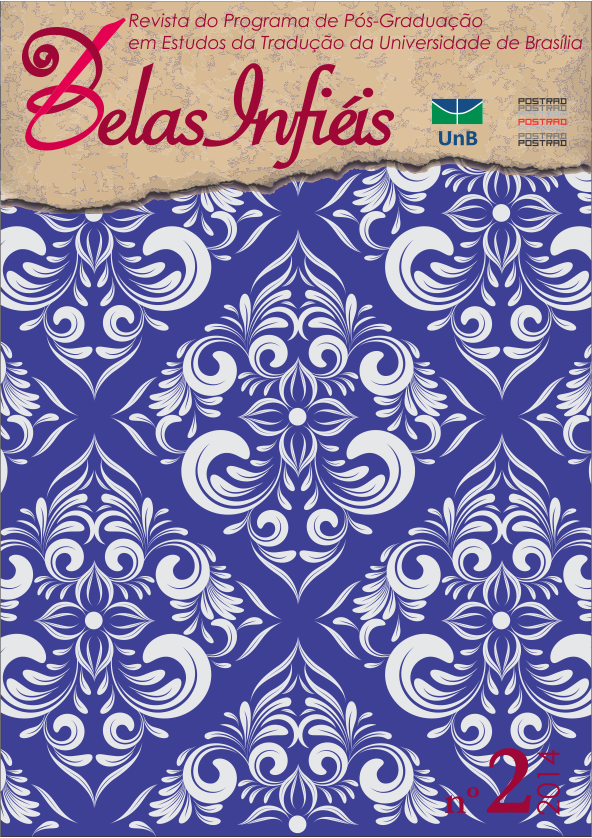QUISSAMA, UMA (PSEUDO)TRADUÇÃO DO SÉCULO XXI
DOI :
https://doi.org/10.26512/belasinfieis.v3.n2.2014.11284Mots-clés :
Pseudotradução, Paratexto, Maicon Tenfen, Literatura brasileiraRésumé
Em 2014, Maicon Tenfen publicou Quissama, uma obra que ele apresenta como a tradução de manuscritos recém-encontrados no Rio de Janeiro. O autor desses manuscritos, um inglês, teria passado pelo Rio de Janeiro na segunda metade do século XIX e ali vivenciado eventos dignos de serem retomados em um livro e apresentados ao público. No entanto, uma simples nota no final do livro revela ao leitor atento que, na realidade, essa obra é ficcional. Estudiosos da tradução ”“ Gideon Toury (2012), em particular ”“ já demonstraram a importância das pseudotraduções no entendimento de fenômenos literários. Portanto, encontrar, em uma obra recente, essa técnica literária geralmente reservada a situações muito especificas incita a se debruçar sobre Quissama. Esse artigo apresenta uma descrição minuciosa dos elementos que sustentam a ideia que a obra é uma tradução. Tais índices podem ser encontrados tanto nos paratextos (principalmente o prefácio e as notas do tradutor), quanto no próprio texto. Apresentamos, em seguida, uma discussão relativa à dificuldade literária que o recurso a uma pseudotradução pode criar para o autor e uma reflexão a respeito dos possíveis motivos que justificaram o seu uso.
Téléchargements
Références
BAKER, Mona(1996) “Corpus-based Translation Studies: the challenges that lie ahead”, inH. Somers(org.) Terminology, LSP and Translation: Studies in Language Engineering, in Honour of Juan C. Sager. Amsterdam: John Benjamins,1996,p.175-186.
BARTHES,Roland. L'effet de réel. In:Communications, 11, 1968. Recherches sémiologiques le vraisemblable. pp. 84-89.
BERMAN, Antoine. A tradução e a letra ou o albergue do longínquo. Tradução de Mauri Furlan, Marie-Hélène Catherine Torres e Andréia Guerini.Rio de Janeiro: 7Letras/PGET, 2007.
GELLERSTAM, Martin. Translations as a Source for Cross-linguistic Studies. In: Aijmer, Karin, Altenberg, Bengte Johansson, Mats. (eds), Languages in Contrast. Papers from a symposium on text-based cross-linguistic studies, Lund 4-5 March 1994.Lund: Lund University Press, 1996, p. 53-62.
GENETTE, Gérard. Seuils. Paris: Editionsdu Seuil,1987.
ILISEI, Iustina-Narcisa.A machine learning approach to the identification of translational language: an inquiry into translationese learning models.Wolverhampton, 2012. Tese(DoutoradoLinguística computacional) -Research Institute in Information and Language Processing, University of Wolverhampton, Wolverhampton, 2012.
Koppel, Moshe; Ordan, Noam. Translationese and its dialects. Proceedings of the 49th Annual Meeting of the Association for Computational Linguistics: Human Language Technologies-Volume 1. Association for Computational Linguistics, 2011.
MITTMANN, Solange.Notas do tradutor e processo tradutório: análise e reflexão sob uma perspectiva discursiva. Porto Alegre: Editora da Universidade do Rio Grande do Sul (UFRGS), 2003.
SAINT-GELAIS, Richard. L’effet de non-fiction : fragments d’une enquête. In Colloque en ligne : «L’effet de fiction», 2001.Acessível em: http://www.fabula.org/effet/interventions/16.php, Acesso: 28 set. 2014.
THIESSE, Anne-Marie. La création des identités nationales. Europe XVIIIe-XIXe siècle. Paris: Editionsdu Seuil, 1999.
TOURY, Gideon. Translation, Literary Translation and Pseudotranslation, Comparative criticism 6. Cambridge: Cambridge University Press, 1984, p.73-85.
TOURY, Gideon. Descriptive translation studies ”“and beyond, 2nd expanded ed., Amsterdam: Benjamins, 2012.
Téléchargements
Publié-e
Comment citer
Numéro
Rubrique
Licence
Copyright Statement
Given the public access to this journal, the texts are free to use but requires the recognition of the original authorship and initial publication in this journal to be properly stated.
The journal allows the use of works published for non-commercial purposes, including the right to submit the work to publicly accessible databases. Published contributions are the sole and exclusive responsibility of the author(s).
- When submitting papers to be evaluated by the Belas Infiéis journal, the author(s):
- Declare that the contents of the contributions are original and of their original creation, being entirely responsible for their content if there is an objection by third parties.
- Claim to be aware that they should not commit academic plagiarism.
- Declare that the manuscript has not been published, completely or partially, in Portuguese or another language. If it is a translation it should be submitted to the Translated Articles section.
- Declare that the manuscript is not being evaluated by other journals.
- Declare that the manuscript was not submitted to another journal simultaneously.
- Commit(s) to inform the journal of any kind of error or inaccuracy in their contribution (published, in evaluation or in editing) and to collaborate with the editors to make due corrections of the article (when in evaluation or editing) or erratum/retraction (after publication).
- Declare that there is no conflict of interest regarding the published work.
- Authorize its release if it is accepted for publication without any kind of monetary compensation.
- Agree to assign non-exclusive rights to publication to the magazine, remaining free to make their contribution available in other media as long as the publication of the first version in Belas Infiéis magazine is mentioned. They also authorize Belas Infiéis to assign their texts for reproduction in content indexers, virtual libraries and similar platforms.
- Maintain copyright and grant the journal the right of first publication, the work being licensed under theCreative Commons Attribution License.
- Is/Are allowed and encouraged to publish and distribute their work online after the editorial process, which may increase the impact and citation of the published work.
- Authorize the editorial team to make textual adjustments and to adapt the article to the publication rules, when necessary.



















